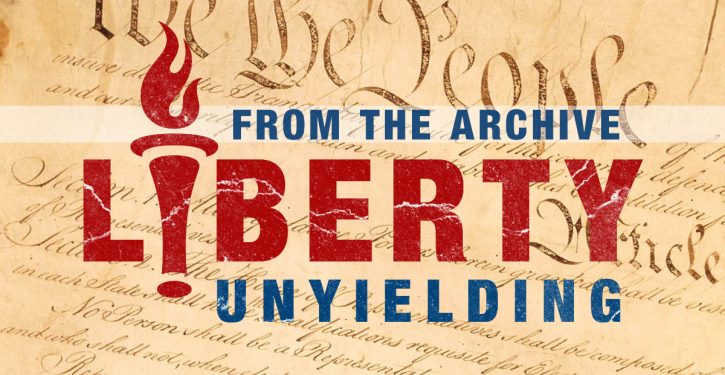
The Education Department has launched “a civil rights probe of Richmond Public Schools at the request of advocacy groups who say the district’s disciplinary policies discriminate against black students and students with disabilities.” The probe was announced in an April 12 letter from the District of Columbia regional office of the Education Department’s Office for Civil Rights. The groups that filed the complaint, the Legal Aid Justice Center and the ACLU of Virginia, cite data showing “Black students with disabilities were nearly 13 times more likely than white students without disabilities to receive short-term suspension.” Comparing blacks with disabilities to whites without disabilities seems like an odd, apples-to-oranges comparison, since students with emotional or behavioral disabilities may be more likely to act out in class, or attack their classmates or teachers, due to emotional problems — and thus have higher suspension rates than those without disabilities for legitimate non-discriminatory reasons (even though the federal Individuals with Disabilities Education Act makes it harder to suspend students with disabilities than it is to suspend students without disabilities).
Perhaps realizing that they had no evidence of actual racism, the groups base their discrimination complaint on “disparate impact” — the idea that even colorblind policies amount to discrimination when they impact more minorities than whites. The Richmond Public Schools have lots of black teachers and staff, so suggesting that these suspensions are due to racism or ill-will towards black people would stretch the bounds of credulity. The complaint seeks to compel the Richmond Public Schools to make discipline laxer by reducing suspensions and using “restorative justice,” and by curbing what they view as overly subjective policies regarding suspensions. This push will backfire on students, most of all on black students. And it will likely lead to lawsuits against the Richmond Public Schools by teachers and students who have to put up with abuse from students who are no longer suspended, but left in the classroom.
Black students are suspended at higher rates than white students in Richmond. But that hardly is a sign of racism. As one commenter put it, “the system is 90% black [or Hispanic]. There are hardly enough white kids to make a valid comparison. The white kids who are there are from high earning homes concentrated around Fox and Mary Munford.” The appeals court in Richmond has rejected the idea that racial disparities in suspension rates show discrimination. Faced with “statistics [that] show that of the 13,206 students disciplined” in a North Carolina school district “from 1996–98, sixty-six percent were African–American,” it said, this “‘disparity does not, by itself, constitute discrimination,’” and was “no evidence” that the school district “targets African–American students for discipline.” (See Belk v. Charlotte-Mecklenburg Board of Education, 269 F.3d 305, 332 (4th Cir. 2001) (en banc)).
Will this presidential election be the most important in American history?
Such disparities may not even amount to unintentional discrimination of the “disparate impact” variety. Even “disparate impact” complaints are supposed to be based on statistical findings that control “for various factors that one would expect to be relevant to the likelihood of disciplinary action.” (See Caridad v. Metro-North Commuter Railroad Co., 191 F.3d 283, 292-93 (2d Cir. 1999); see also Ward’s Cove Packing Co. v. Atonio, 490 U.S. 642 (1989)). Factors linked to student misbehavior and disciplinary action include, but are not limited to, living in poverty, or coming from a single-parent household, challenges that disproportionately confront black students. Student misconduct rates are much higher in schools where poverty is common, especially abuse aimed at teachers: verbal abuse aimed at teachers is five times higher in such schools. (See Rachel Dinkes, et al., Indicators of School Crime and Safety: 2007 (National Center for Education Statistics, 2007, pg. 26)). Misbehavior is also much more common among students from single-parent households. As the Brookings Institution has pointed out, “black students are also more likely to come from family backgrounds associated with school behavior problems; for example, children ages 12–17 that come from single-parent families are at least twice as likely to be suspended as children from two-parent families.” (See Tom Loveless, The 2017 Brown Center Report on American Education: How Well Are American Students Learning? (Brookings Institution, March 2017, pages 30-31)).
As Katherine Kersten pointed out last year in the Minneapolis Star-Tribune, black students’
discipline rate is higher than other students’ because, on average, they misbehave more. In fact, a major 2014 study in the Journal of Criminal Justice found that the racial gap in suspensions is “completely accounted for by a measure of the prior problem behavior of the student.” That problem behavior can manifest itself in other ways. Nationally, for example, young black males between the ages of 14 and 17 commit homicide at 10 times the rate of white[s]…Why such a gap? A primary reason is likely dramatic differences in family structure. Figures for St. Paul are not available, but nationally, 71 percent of black children are born out of wedlock…while the rate for whites is 29 percent. Research reveals that children from fatherless families are far more likely than others to engage in many kinds of antisocial behavior.
In its past investigations of school districts, though, the Office for Civil Rights has sometimes failed to control for any race-neutral factors, wrongly assuming that any difference in suspension rates between blacks and whites makes out a prima facie case of disparate impact. In addition to sometimes misapplying the disparate-impact concept, the Education Department may not even have the power to apply it to begin with. The Supreme Court has expressed skepticism about the validity of the Education Department’s disparate-impact regulations, since they were adopted pursuant to the Title VI statute, which the Supreme Court has ruled only bans intentional discrimination, not disparate impact. (See Alexander v. Sandoval, 532 U.S. 275, 286 n.6 (2001) (calling the case for disparate-impact rules under Title VI “strange”)).
The curbs on suspensions that the Richmond complaint seeks will likely backfire on students, especially black students, and will lead to additional lawsuits. When New York City restricted principals’ ability to suspend students, and increased reliance on “restorative justice” approaches, there were increases in violence and gang activity in schools, with blacks suffering most from that. As the Manhattan Institute’s Max Eden observed, “teachers report less order and discipline, and students report less mutual respect among their peers, as well as more violence, drug and alcohol use, and gang activity. There was also a significant differential racial impact: nonelementary schools where more than 90% of students were minorities experienced the worst shift in school climate under the de Blasio reform.” (See School Discipline Reform and Disorder: Evidence from New York City Public Schools, 2012-16 (Manhattan Institute, March 2017)). University of Rochester professor Joshua Kinsler earlier discovered that “in public schools with discipline problems, it hurts those innocent African American children academically to keep disruptive students in the classroom,” and “cutting out-of-school suspensions in those schools widens the black-white academic achievement gap.”
Restorative justice approaches and other forms of lax discipline also lead to lawsuits against school districts by teachers and students who have to put up with abuse from students who are no longer suspended, but left in the classroom. In an April 19 column, the black economics professor Walter Williams gives an example of a teacher in a South Carolina school district who sued for racial and sexual harassment at the hands of students who were not removed from her classroom despite repeated verbal abuse: “a white Charleston, South Carolina, teacher frequently complained of black students calling her a white b——, white m——-f——-, white c—- and white ho. School officials told her that racially charged profanity was simply part of the students’ culture and that if she couldn’t handle it, she was in the wrong school. The teacher brought a harassment suit, and the school district settled out of court for $200,000.” Teachers assaulted by students have also brought lawsuits.
Laxer discipline does not, by itself, eliminate disparities in the suspension rate between blacks and whites. That’s because it cuts the suspension rate for both blacks and whites, rather than just cutting the black suspension rate. In fact, laxer discipline sometimes cuts the suspension rate even more for whites than for blacks, resulting in an even bigger ratio of suspended blacks to suspended whites, as the Washington lawyer and numbers-cruncher James Scanlan notes. Scanlan, who has degrees from Harvard Law School and the London School of Economics, points to examples from cities like Denver, Colorado, where the ratio of the black suspension rate to the white suspension rate went up from less than 4 to 5.5 after the schools began making discipline more lenient. In the San Francisco Recorder, Scanlan argued that it is a mistaken assumption “that stringent discipline policies tend to cause large racial disparities in discipline rates. Exactly the opposite is the case. Stringent discipline policies tend to yield smaller racial differences in discipline rates than more lenient ones.”
The complaint prudently doesn’t ask the Education Department to reduce the suspension rate of blacks to the suspension rate of whites, which would be illegal — although such demands have been made in past complaints, and the complaint does demand identification of the causes of “race and disability disparities” and “recommendations for reform.” In past settlements with the Office for Civil Rights, some school systems have agreed to “targeted reductions” in “suspensions for African American students,” to resolve discrimination complaints against them with the Education Department. But those are racial quotas all but name, and the appeals court in Richmond has taken a dim view of such racial quotas. In its ruling in Belk v. Charlotte-Mecklenburg Board of Education, 269 F.3d 305, 332 (2001), the court rejected the idea that suspension rates should be made equal among all groups, declaring that the notion that a school system “should have a disciplinary quota is patently absurd.” Similarly, the appeals court in Chicago blocked a provision that forbade a “school district to refer a higher percentage of minority students than of white students for discipline unless the district purges all ‘subjective’ criteria from its disciplinary code,” because that constituted an illegal racial quota. (See People Who Care v. Rockford Board of Education, 111 F.3d 528, 538 (7th Cir. 1997)).
One hopes that the Richmond Public Schools will not try to resolve this discrimination complaint by offering to adopt a racial quota in suspensions. That is something that could lead to reverse discrimination lawsuits against it by affected students and teachers. (See, e.g., Huckabay v. Moore, 142 F.3d 233 (1998) (white employee could sue for racial harassment); Parents Involved v. Seattle School District, 551 U.S. 701 (2007) (successful reverse discrimination lawsuit by mostly white parents)).
The desire of the Richmond complaint to eliminate “subjective” elements in discipline seems hopelessly impractical. As the appeals court in Chicago noted, some of the most important school rules are inherently “subjective,” but they cannot be discarded on that basis: for example, although rules against “disrupting classes” are to some extent “subjective,” they are nevertheless essential and cannot be sacrificed to achieve racial balance, since they serve “important disciplinary criteria.” (See People Who Care v. Rockford Board of Education, 111 F.3d 528, 538 (7th Cir. 1997)). Moreover, there is no evidence that “subjectivity” is the cause of blacks being suspended at a higher rate than whites. Indeed, the appeals court in Philadelphia found to the contrary, noting that blacks had the highest suspension rates relative to whites for “very objective offenses.” (See Coalition to Save Our Children v. State Board of Education, 90 F.3d 752, 775 (3d Cir. 1996)).




